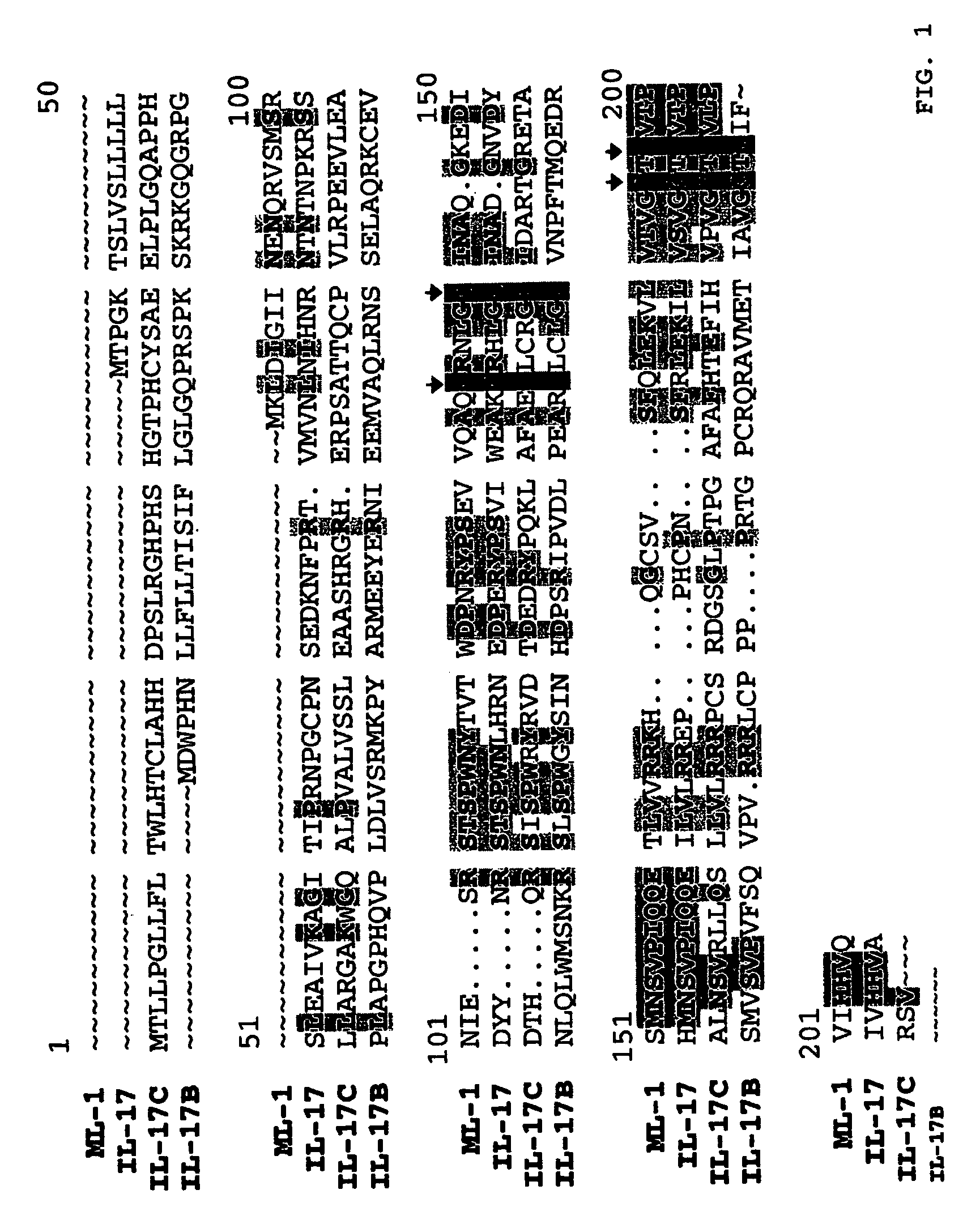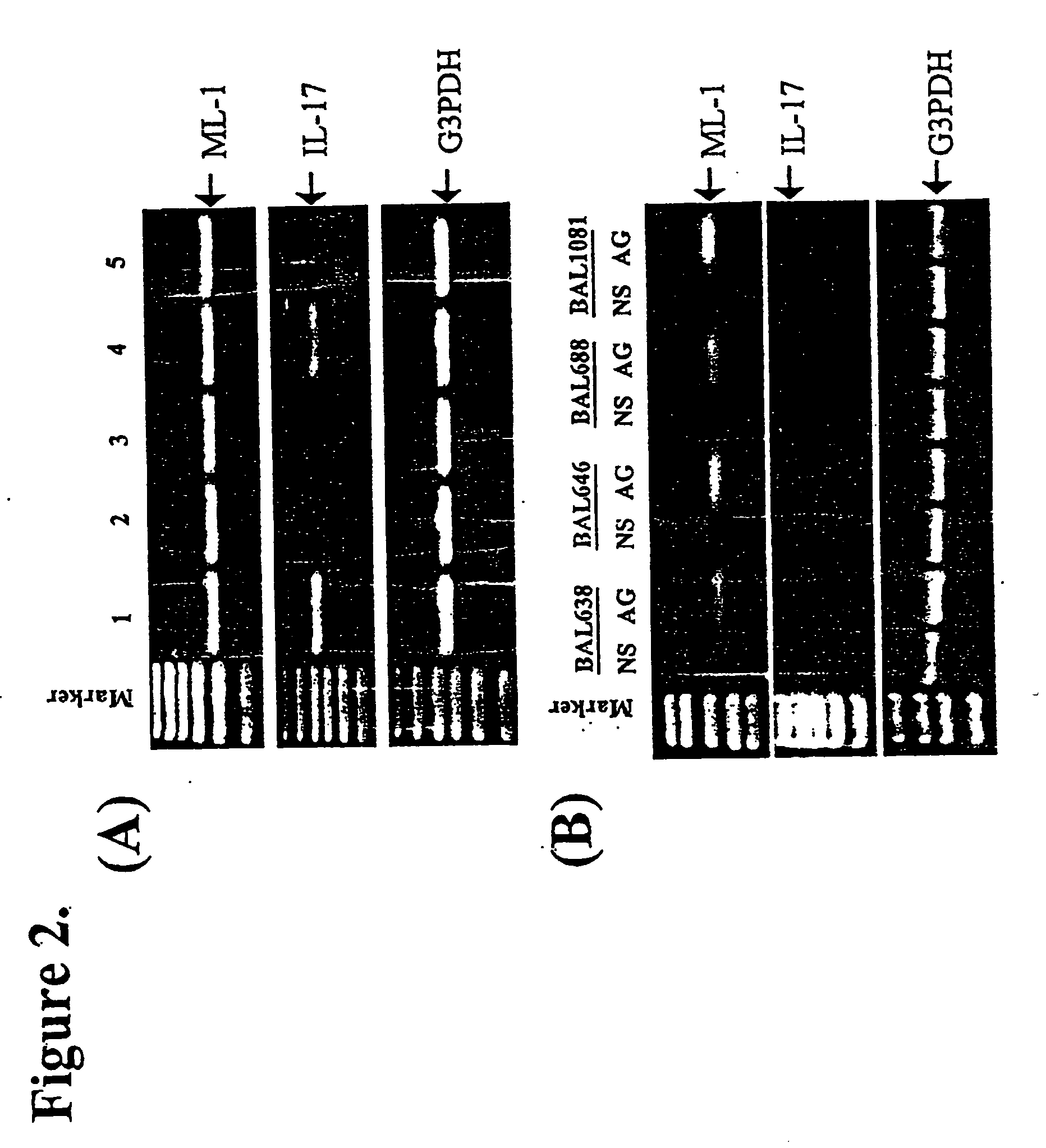Cytokine structurally related to IL-17
a cytokine and cytokine technology, applied in the field of new cytokine, can solve the problem that the il-17c cannot stimulate the il-6 production of human fibroblasts, and achieve the effect of reducing the symptoms of airway inflammation, reducing the expression of human ml-1, and reducing the effective level of ml-1 protein
- Summary
- Abstract
- Description
- Claims
- Application Information
AI Technical Summary
Benefits of technology
Problems solved by technology
Method used
Image
Examples
example 1
Full-Length cDNA Sequence of ML-1 Gene
[0100] As part of a positional cloning study of a region on chromosome 6p for susceptibility gene discovery for an inherited disease, a potential coding-region sequence with homology to human IL-17 was identified from a genomic DNA clone, PAC108C2* (Sanger Centre Database, URL address: http file type, www. host server, domain name sanger.ac.uk), using the GenScan prediction program. The predicted expressed sequence with a centromeric-telomeric orientation was composed of 2 exons of 221 and 238 basepair, respectively. RT-PCR and sequencing analysis of activated, human allergen-specific T-cell clones confirmed the predicted sequence and the splicing sites between the exons. However, the open-reading frame utilized a start codon 129 basepairs 3′ to the predicted start site, encompassing a 92-bp segment in the first exon. A 9476 full-length cDNA was obtained using both 5′- and 3′-RACE, revealing a transcription start site 346 basepairs upstream of...
example 2
Cells, Isolation of RNAs, and Expression Analysis; Tissue and Cellular Distribution of the ML-1 Gene
[0102] Tissue distribution data for IL-17 and ML-1 were acquired using Rapid-Scan gene expression panels for human tissues (OriGene Technologies, Inc., Rockville, Md.) according to the manufacturer's instructions, with 5 mM magnesium and ML-1-specific primer pairs. The sequences of primers for ML-1 were as follows: forward, 5′-GGCATCATCAATGAAAACCAG-3′ (SEQ ID NO:10) and reverse, 5′-TCACCAGCACCTTCTCCAAC-3′ (SEQ ID NO:11). PCR products were visualized on an ethidium bromide-containing gel and photographed. Tissues were graded on a 0-4 grading system, based on visualization of bands at the concentrations of cDNA provided by the manufacturer (grade 4=product obtained with >1 pg / ml; grade 3=product obtained with >10 pg / ml; grade 2=product obtained with >100 pg / ml; grade 1=product obtained with 1000 pg / ml; grade 0=no product obtained with 1000 pg / ml). Appropriate normalization of cDNA pro...
example 3
Recombinant ML-1-His fusion Proteins
[0107] The coding sequence of ML-1 was amplified by PCR and subcloned into the Bam HI and Sal I sites of pcDNA 3.1 (Invitrogen, Carlsbad, Calif.) to generate a C-terminal fusion gene with the His and cMyc tags. The vector pcDNA 3.1 was transfected into COS-7 cells by an Effectene Reagent (Qiagen, Chatsworth, Calif.) according to the manufacturer's instructions. Two days after transfection, the supernatants were concentrated over Centricon-10 columns (Amicon, Beverly, Mass.) and subjected to affinity purification by Ni—NTA agarose beads (Qiagen, Chatsworth, Calif.) for His-tagged proteins. To examine the protein expression, SDS-PAGE analysis was performed on the affinity-purified, recombinant proteins under a reducing condition, followed by Western Blot analysis using anti-His monoclonal antibody (Santa Cruz Biotechnology, Inc., Santa Cruz, Calif.).
PUM
 Login to View More
Login to View More Abstract
Description
Claims
Application Information
 Login to View More
Login to View More - R&D
- Intellectual Property
- Life Sciences
- Materials
- Tech Scout
- Unparalleled Data Quality
- Higher Quality Content
- 60% Fewer Hallucinations
Browse by: Latest US Patents, China's latest patents, Technical Efficacy Thesaurus, Application Domain, Technology Topic, Popular Technical Reports.
© 2025 PatSnap. All rights reserved.Legal|Privacy policy|Modern Slavery Act Transparency Statement|Sitemap|About US| Contact US: help@patsnap.com



